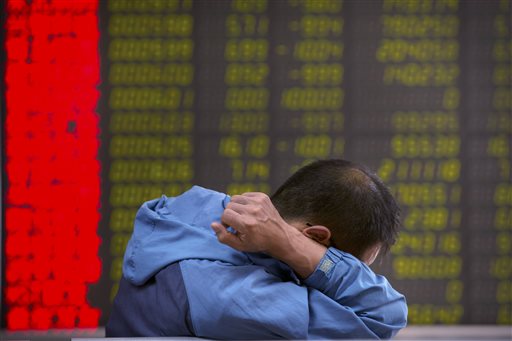
A Chinese investor monitors stock prices at a brokerage house in Beijing, Tuesday, Aug. 25, 2015. China’s main stock market index has fallen and a reversal in manufacturing figures have led to global markets plunging Tuesday, September 1, 2015. AP
NEW YORK, United States — World stock markets plunged further on Tuesday as more evidence emerged of China’s economic slowdown, triggering heavy sell-offs from Tokyo to New York and spurring cuts to global growth forecasts.
A three percent drop in stocks on Wall Street wound up the dismal day for investors, who dumped shares of the largest, most blue-chip banks and tech companies and headed for safety in bonds.
The spark for the day’s rout came from fresh official data that showed industrial activity in China stalling.
The official purchasing managers’ index (PMI) for manufacturing activity came in at 49.7 last month, its lowest for three years and indicating a contraction in factory activity.
That added to the concern over the health of China’s economy — the world’s second-largest — and how its slowdown would affect the rest of the world.
Adding her voice to private sector economists that have already cut their world growth estimates, International Monetary Fund managing director Christine Lagarde said growth would likely be weaker than the 3.3 percent estimate the IMF made just two months ago.
Speaking in Indonesia, she warned that emerging economies “need to be vigilant to handle potential spillovers from China’s slowdown and tightening of global financial conditions.”
And a US Treasury official said Washington’s key focus in the meeting of G20 economy chiefs in Ankara later this week would be to press for action to boost global demand, and to urge Beijing authorities to better communicate their policies for shoring up the economy and markets.
Shanghai stocks lost 1.23 percent and Hong Kong shed 2.24 percent after the release in China of the official PMI figures.
Tokyo was rocked more heavily, losing 3.84 percent, feeding into losses in Europe that hit 3.03 percent in London, 2.38 percent in Frankfurt and 2.40 percent in Paris.
Across the Atlantic, the S&P 500 gave up 2.96 percent and the Dow slightly less.
“Equity markets (are) starting the new month in the red after yet more disappointing China manufacturing data increases concerns about (the) slowing of the world’s number two economy,” said analyst Mike van Dulken at Accendo Markets.
“The market is in a situation where it can only see reasons to fall. We are adapting to a world where economic growth is going to be slower than believed in recent months, because of the hit from China and the emerging economies,” said Gregori Volokhine of Meeschaert Financial Services.
The Chinese data spilled over into oil markets, which reversed course and saw prices fall in London by 8.5 percent after three straight gains.
“The (Chinese) manufacturing index still shows that the economy is in the process of seeking a bottom,” said Wu Kan, a Shanghai-based fund manager at JK Life Insurance.
Hit on German industry
Claus Vistesen, chief eurozone economist at Pantheon Macroeconomics, said China’s problems would impact Germany, Europe’s largest and strongest economy.
“The slowdown in China will weigh on German manufacturers, despite strong domestic growth and solid demand in the US and the UK,” he said in a client note.
“It is unrealistic to expect a complete decoupling, given the strong Chinese contribution to global GDP growth.”
Some analysts were not so pessimistic.
“We don’t think the readings are cause for alarm. For a start, China’s economy is increasingly driven by service sector activity, which still appears healthy. As such, signs of weakness in manufacturing are less of a concern than they used to be,” said Chang Liu at research firm Capital Economics.